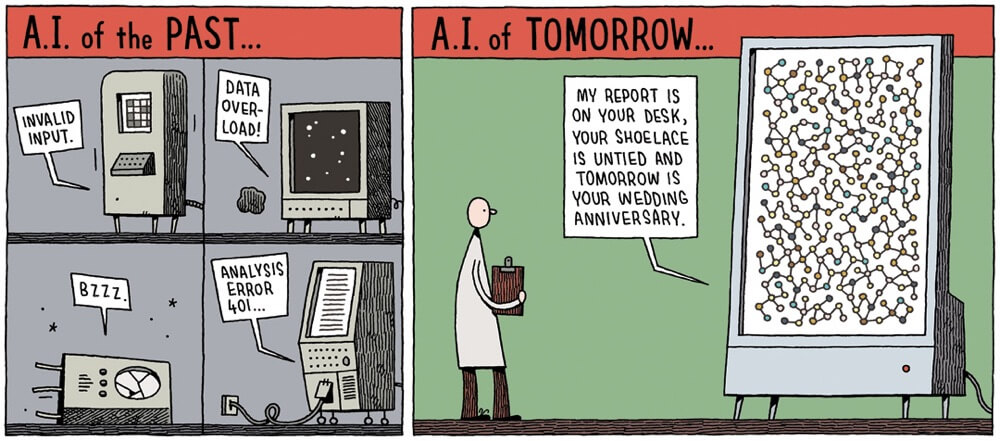
Blog / Smart Underwear Revisited – AI to be Next Big Thing
I will confess it’s a very welcome break from Alberta’s cold and snow, but the main reason we attend is to pick up on Industry Trends. We know that Technology introduced at CES will show up in our Clients’ homes and businesses three to five years later. We care less about Smart Underwear and more about how it connects to a Client’s network, what information it gathers, and how it’s protected (no Depends jokes please.)
A trend we picked up on last year was AI. AI means Artificial Intelligence. This is one of these notorious Industry terms that has no solid definition; it’s whatever the Marketing Team want you to believe about their AI-enabled product. I’m willing to bet the house that AI will be injected into everything at CES this year. AI Underwear anyone?
AI conjures up images of Robots from Sci-Fi movies; R2D2 and C3PO are the obvious ones. Somewhat more disturbing is the iRobot movie, and all the way to the dark side, is the Terminator series.
AI has it’s roots in Machine Learning. The concept is simple. A device alters it’s behaviour or reply, based on previous calculations and responses. Think of a simplistic example: an AI-enabled calculator adds 1 + 2 and gives an answer of 5. You enter the correct answer of 3 into the calculator. and again ask the calculator to add 1 + 2. This time the answer comes back as 3.
AI requires two elements to be useful beyond our simple example: massive Processing Power and Storage (to process complex algorithms that facilitate learning), and copious amounts of Sample Data that it can learn from. Both of these capabilities are recent developments in the IT world.
New developments in Chip Technology, combined with small size and mass-production, have brought the promise of AI to Consumer devices. These devices can now perform rudimentary AI-enabled functions. More sophisticated AI computing is still reserved for larger servers, but they are well within the reach of Tech giants like Google, Amazon, Microsoft, Facebook, and Apple. And it is now also starting to show up in smaller organizations.
The other element is Data – lots of it (often called Big Data.) The importance of data lies in the need to have a lot of samples that feed the machine learning; the more samples, the more accurate the results. A practical example is Speech Recognition: The ability of a device to recognize voice commands. These systems have been around for more than a decade. But they have been notoriously inaccurate. Early systems required that you train the device to listen to your commands as you pronounced them; this in itself was a rudimentary form of AI. It improved accuracy, but was far from convenient and was still prone to a lot of errors. They also only recognized a handful of commands.
Today’s Speech Recognition appears to be magical by comparison. They recognize just about any word or phrase without training. They understand contractions, idioms, accents, different languages and dialects – and even work in noisy surroundings. How?
The answer is lots of speech samples combined with sophisticated linguistics. The linguistics form the AI algorithms with feedback to correct mistakes, and the samples come from billions of spoken words that are digitized and captured. Tech giants like Google, Amazon and Apple have been collecting digitized speech for several years through Smartphones and other APP’s. I will let the Cyber Security gurus ponder that.
Most AI systems have a single purpose: Speech Recognition, (soon-to-be) self-driving cars and stock market buy-sell programs are common examples. The ability to combine multiple AI functions into a single system is the future; the robot that understands your breakfast order and drives to the restaurant, while adjusting your stock portfolio, isn’t coming to a home near you anytime soon.
AI will be embedded in a lot of hidden functions that you won’t be aware of. I recently attended a Digital Marketing Seminar and AI is now being used to direct Automated Marketing, by combining Facebook, LinkedIn and Google Personal Profiles with Search Engine Results, to tailor what information you see – and then guide you as you click through multiple links, to become educated on a certain product choice. This is forwarded to the company’s Sales Department as a qualified lead, which then spawns a personalized response “just for you.” In some instances, the personalized response is delivered to you by an Automated Attendant powered by AI. It’s part of a trend called Inbound Account Marketing.
Of course, AI will also be used as Marketing hype; attached to just about any product, whether it has a legitimate AI component or not. Expect to see “AI Enabled!” splashed across every product packaging, from televisions to light bulbs. We also expect to be inundated at CES with an AI blitz.
In the meantime, you can contemplate what the AI Underwear of the future will do – or where they get their sample data from.
Hmm, perhaps NOT.
Stay tuned for future reports from CES.
All the best this Holiday Season and we’ll see you next year for some stress-free IT.
Thanks!
Dave White
TRINUS
stress-free IT
trinustech.com

















